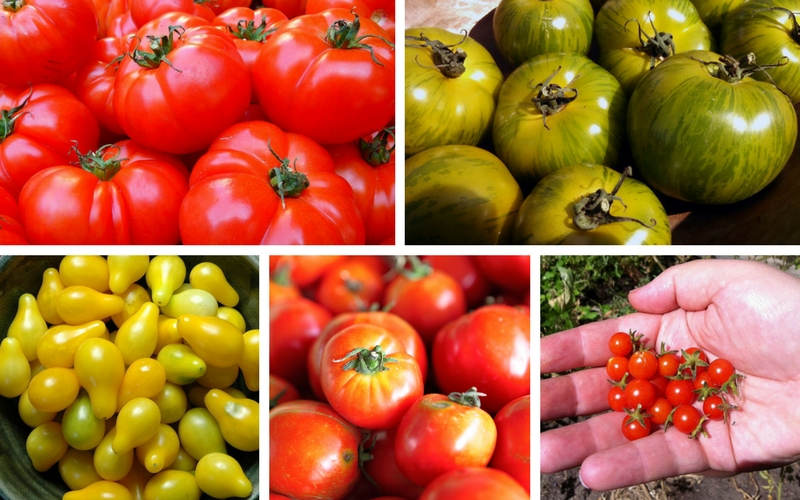Tomatoes are a delicious and healthy taste of summer. While most people think of red tomatoes, there are actually many different varieties of tomatoes that range from red, orange, and yellow, to deep purple or black, as well as many striped varieties. Growing tomatoes gives you the opportunity to enjoy a rainbow of color in your garden and at your table. The plant is generally easy to grow, but is prone to a number of pests and diseases. The following seven tips about how to grow tomatoes from seeds can help you grow healthy plants loaded with beautiful, luscious tomatoes.
Choose Your Location
Tomatoes thrive in sunshine and warm weather. Choose a location in your garden that receives full sun and has well-drained soil. If the soil stays wet or soggy, then consider building a raised bed for planting. It is important to rotate where you grow tomato plants on a three year cycle because many of the diseases that affect tomatoes live in the soil. Planting tomatoes in the same place every year increases the risk of disease. Potatoes, peppers, and eggplants, like tomatoes, are part of the nightshade family. When rotating tomato crops, avoid planting them where these plants were the year before. Instead, rotate with unrelated crops like beans, corn, or lettuce.
Pick a Variety
When choosing what kind of tomato plant you want, consider the size, color, and type. Tomatoes range from small cherry size to large beefsteak; your preferences and intended use influence which will be the best for you. Color is also a matter of personal preference. There are two main types of tomato plants, determinate and indeterminate. Determinate varieties are usually smaller, grow to a certain size, and set their fruit more or less all at once. This type is good for people with limited space. Indeterminate varieties grow continually don't stop growing and can get very tall; they set fruit throughout the season. Many people think that indeterminate varieties tend to taste better, but both types can produce great tomatoes.
Start Your Seeds
Growing tomatoes from seeds is a good choice if you want a lot of tomato plants. Tomato seeds can be started indoors six to eight weeks before the last frost date for your area or outdoors once the last frosts for the year have passed. Choose a suitable container and lightly cover seeds with soil. Place the seeds in a warm location to encourage sprouting, and use a spray bottle to keep the soil damp. Once the seeds have sprouted, provide the seedlings with plenty of light by moving them to a sunny window or using grow lights. Seedlings need a breeze to develop strong stems, so if you are growing them indoors use a fan to create a breeze for at least ten to twenty minutes per day. Harden off seedlings by gradually moving them outdoors, first in a shady area, then in the sun, for at least a week before transplanting them.
Transplanting Seedlings
Tomatoes may be transplanted to your garden after the danger of frost has passed. They love warm soil, so preheating your soil for a couple weeks by covering it with plastic can be helpful, particularly in cooler climates. Plant tomatoes deeper than they are in their pots; bury the stem and even some of the lower leaves so that just the top few leaves are above the soil. The lower portion will develop new roots, which make the plant stronger. Water your plants well for the first few days after transplanting to reduce the shock to the roots.
Stake Early
Although staking or caging your tomato plants is not required, it is usually a good idea. Staking keeps the tomato plants up off the ground which makes them take up less space in your garden and also helps protect the plant from disease and pests. If you choose to cage or stake your tomatoes, do so early on to avoid damaging the branches or roots.
Water Regularly
Regular watering is key to growing healthy tomatoes because many problems with tomatoes are due to under- or over-watering. Avoid overhead watering because airborne spores can infect the plant after landing on the wet leaves. Drip irrigation or a soaker hose are good options. Tomatoes need at least 2.5cm of water per week. In areas with hot, dry weather, watering every morning may be appropriate, while cooler areas often only need watering every two to three days.
Minimise Dangers
Tomato plants are susceptible to a number of diseases and pests. The best ways to prevent damage to your plants are to water evenly and regularly, rotate your crops, and plant your tomatoes with a variety of other plants. Spacing your tomatoes away from each other and planting other things around them helps protect them from pests and disease. Borage, marigolds, chives, nasturtiums, basil, sage, onions, chillis, and calendula are particularly helpful. If you notice a diseased plant or fruit, remove it promptly from the garden and throw it away to prevent the spread of disease. Never compost diseased plants.
Growing tomatoes from seeds is a fun, exciting, and sometimes challenging project that usually produces a delicious result. A little care is required to grow tomatoes well, but with these seven tips, you are on your way to growing wonderful, great-tasting tomatoes.
Browse our full range of tomato seeds.
Browse our full range of tomato seeds.






